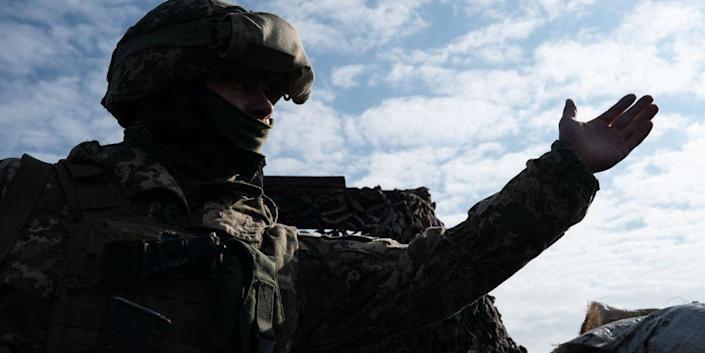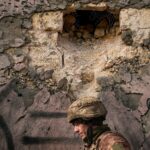
Leonid Ostaltsev is a 35-year-old former soldier who now runs Veterano’s, a popular pizza chain in Ukraine. He fought for his country against separatists and Russian forces, and now says he is eager to do so again. One wall of the central Kyiv branch of his shop is covered in military patches and insignias, while on the wall is a map of Ukraine made out of spent shell casings. His desk is covered with a wide range of modern weaponry next to photos of his children.
“When I went to fight for the army in July 2014, I bought my own uniform, wore New Balance shoes, and my friends all pitched in to buy me body armor, which was in a terrible condition,” he says. “In one whole year of military training before the war, I shot only six bullets, two times. The training was so poor that I had to Google ‘how to set up a checkpoint’ so that our friends wouldn’t get killed if we had to fire at the enemy. Funny… but not funny. It is a big difference now.”
Earlier this week the United States declared that Russia was “on the brink” of a devastating invasion of Ukraine that would include the targeting of the capital, Kyiv, which has a population of about 2.8 million. And early Thursday in Europe, Russian President Vladimir Putin officially declared military action in the Donbas region of eastern Ukraine. The death toll could be in the hundreds of thousands. Already, Russia has officially moved its forces into the occupied territories claimed by the Donetsk and Luhansk People’s Republics, tearing up a long standing peace agreement known as the Minsk Accords.
How would the Ukrainian armed forces fare now, in the face of such an existential threat?
When Russian forces invaded and annexed Crimea in 2014, Ukraine’s military was in such a pitiful state that their western advisors told them to forget about putting up a military fight for the peninsula, a decision that still rankles with many commanders in Ukraine. When the war with Russia and its separatist proxies broke out in the eastern regions of Donetsk and Luhansk, known as the Donbas, Ukrainian commanders were caught unaware and initially lost large amounts of territory.
Many soldiers and volunteers had little to no body armor and used outdated Soviet-era weaponry. They had a poorly trained force of about 6,000 combat-ready soldiers. Many of those who fought in the early months of the war were volunteer brigades.
“Our soldiers were cleaners and painters, not soldiers,” Ostaltsev says. “In my country, our government had sold almost everything we had after the fall of the Soviet Union. I was in the regular army for one year, and I know the army fighting against Russians in 2014. We didn’t know anything. It was men and women in very bad uniforms without any combat experience or useful skills that can help in a battle.”
The separatists in the Donbas, on the other hand, were supported by Russian troops and supplied with modern heavy weapons. These included tanks and ballistic missile systems, such as the BUK surface-to-air missile launcher that infamously shot down the MH17 passenger jet over eastern Ukraine in July 2014.
In February 2015, after a major defeat for Ukrainian forces at the Battle of Debaltseve, then-President Petro Poroshenko was forced to accept the Minsk agreements, which proposed a form of autonomy for separatist-controlled regions that many believe would give Moscow an effective veto over Ukrainian foreign policy decisions.


But eight years of war in the Donbas region has led to a major investment in the modernization of Ukraine’s armed forces, and a series of reforms to command structures to bring them closer to NATO standards. Soldiers are also far better trained, with many of them having had a baptism of fire in the trenches of the eastern war.
“Now we are an absolutely different army.” Otsaltseve tells me. “We have something almost no other army in the world has: We have combat experience, and we know what war with a stronger enemy is, where you don’t have anything but you need to fight because it is your homeland.”
Since the outbreak of war, the Ukrainians have doubled their defense spending to around 3.4 percent of GDP and now has perhaps 250,000 service people under arms and close to 1 million reservists. Russia, on the other hand, has approximately 900,000 service people across all branches of its military. About 200,000 of those are believed to have been stationed on the Ukrainian border, waiting for their signal from the Kremlin to invade.
Ukraine’s military hardware has also undergone a massive upgrade. Western allies have been supplying Ukraine with Javelin handheld anti-tank missiles as well as shoulder-mounted anti-aircraft missiles.
Possibly the biggest wild card in Ukraine’s arsenal is their six Bayraktar TB2 combat drones. Azerbaijan used these high-tech UAVs to crush the under-equipped Armenian military in 2020’s Nagorno-Karabakh War. If the coming conflict was confined to the Donbas region, this could mean the Ukrainian armed forces could be equipped to regain their territory by military means. But they are unlikely to be a game changer against Russia, whose forces are equipped with short range air defense, including electronic jamming devices that can cut the link between controller and aircraft.
Few Ukrainian or Western military officials believe they have a prayer against the Russian army in open terrain warfare. Justin Bronk, an expert at the Royal United Services Institute, a London-based think tank, is pessimistic about the Ukrainians chances in conventional warfare.
“Encircling Kyiv within 36-72 hours is entirely within the capabilities of the Russian forces massed around Ukraine” he told Popular Mechanics earlier this week.
“If you were to pitch small infantry units against each other you’d probably end up with quite a positive Ukrainian result. But of course, that isn’t the way the Russian armed forces are going to fight. Where the Russian forces advantages lie, it is mainly in long-range precision fire, ballistic missiles, infrastructure targets, bombard cities if they want to.” Because of Russia’s overwhelming air power advantages, the crack Ukrainian troops on the borders of Donbas will be almost unable to move. As of initial reports Thursday in Ukraine, there were already explosions heard in Kyiv and President Volodymyr Zelensky issued a state of emergency in Ukraine.
“If Ukrainian forces leave their relatively well dug in, relatively well-concealed positions, they will get absolutely obliterated by air attacks,” Bronk says.
The glimmer of hope for the defenders is that Ukrainian forces may be much better equipped to fight in cities, which are much more difficult to assault than flat terrain, and where Russian air and long-range missile power will not give them the overwhelming advantage of a conventional ground assault campaign.
“To defeat Russia we need missiles, we don’t have enough artillery or rocket forces,” Ostaltsev says. “If Russia will invade our country without aviation, they don’t have a chance. If they do use it, it will be very bad for us.”
Despite this, he shows off his new collection of guns and claims that he is ready to fight. “If they want to take the cities, they will have to throw everything,” he says. “Not just the regular army, the people’s army will be ready to fight them.”
You Might Also Like




